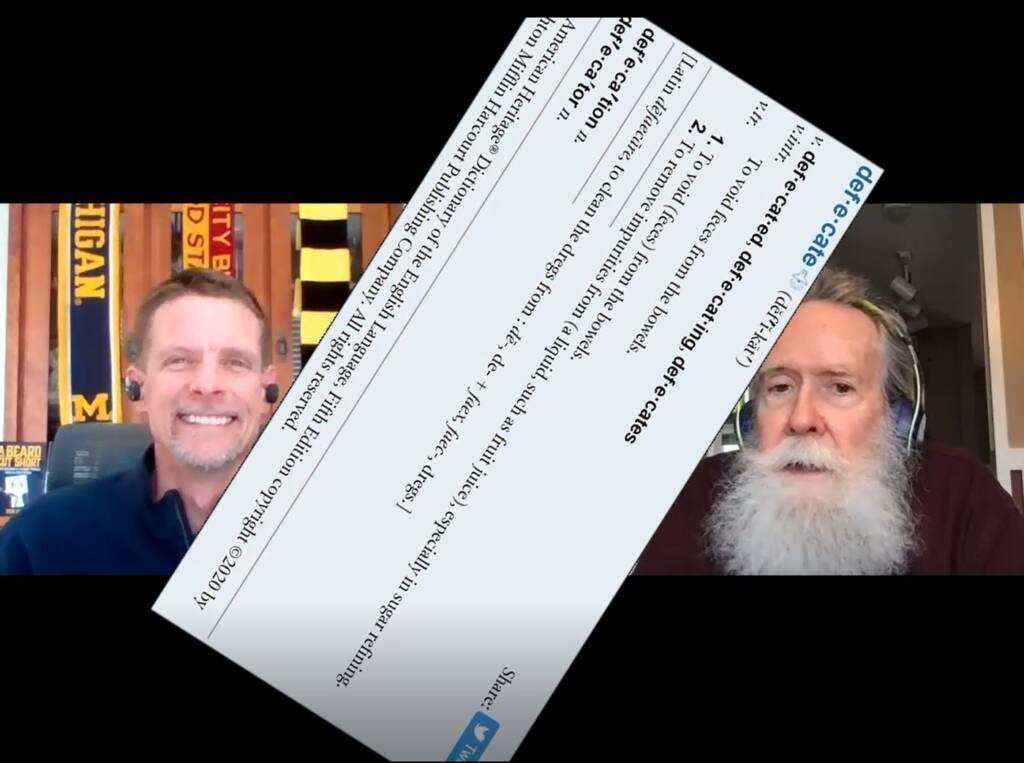
“Grammar Geezers” is two old white guys (combined age: ~133) talking about grammar and writing on YouTube.
The point is not to become the next James Charles, Larray, or Tricia Paytas. (I have teenage daughters.) Neither I nor John Rubadeau, my Grammar Geezers co-conspirator, dream of attending influencer parties.
John taught writing at the University of Michigan from 1987 to 2018. He has an English PhD but never sought tenure. He was more interested in teaching, writing a gargantuan novel, and penning thousands of recommendation letters for those he taught.
John taught me when I was a sophomore in 1989. He soon became one of the most popular teachers at U of M. In 2005, he was awarded the Golden Apple, given annually to the university’s most popular professor as chosen by students. The “lecture” he gave at the award ceremony (I use quotes because this variety show of a presentation involved all sorts of digressions, including one involving a violinist) is on YouTube.
When John’s teaching career ended, I convinced him that we should do a book to share those teachings. This would be, as John took to calling it, “our dirty-grammar book.” (The hyphen is needed because, without it, we could be talking about a book about grammar that has gotten dirty). With the blessing of John’s wife Pat, he flew out to Denver in late 2018, and we spent many hours talking about grammar and writing.
But our dirty-grammar book didn’t happen.
That’s because I became intrigued with John’s life story and with the circumstances surrounding his departure from the University of Michigan. I changed gears, and our dirty-grammar book became A Beard Cut Short, a biography of a great teacher, mentor, and dear friend to so many of his former students.
Some grammar and writing made the book: there’s a historical-present interlude (I could have written “an” historical-present interlude there, but I can’t bring myself to do it in a blog post) in chapter six, and John’s (in)famous Grammar Review is included as a special bonus at the tail end of the book. But there was so much material we didn’t cover.
I proposed another project in a different medium. We would pick a couple of topics every couple of weeks, do a Zoom call, and post short, focused videos. It would not be terribly dirty: frankly, it’s hard to make grammar lessons dirty without forcing it.
That’s the point for me and John. But what’s the point for the reader?
Over his last few years of teaching students, John noted a decline in writing quality among his students. This wasn’t universal: there were still some excellent writers coming in. But he suspected the sloppiness that’s pretty much acceptable in the Twitter/Snapchat/Instagram/Facebook/etc. universe was to blame.
Yet bad writing remains largely frowned upon in the “adult” world – the world of business, government, education, science, choose-your-professional realm. In addition, muddled, sloppy writing too often reflects muddled, sloppy thinking. People who matter – people who hire other people for jobs or consulting gigs or whatever – will often judge intelligence and competence based on written communication. One’s writing serves as a proxy, like an SAT score or an academic pedigree. A smart person who writes poorly can seem less smart than she is. This is not generally advantageous.
And there’s this: in business and government, better communicators quite obviously get ahead. But a computer engineer, chemist, physicist, or cellular biologist who communicates more clearly will, over the long haul, do better even in highly technical fields. I’ve seen it as a science writer for years now; John has seen it among former students for decades: the truly elite can do the science and technology. But they can also clearly explain it to their uncles.
In short, Grammar Geezers is not about rocketing us all to Iowa Writers’ Workshop altitudes. It’s about meeting standards.
Those standards are on a sliding scale. Let’s use video editing as an example. I knew zero about video editing when I proposed Grammar Geezers to John a couple of weeks back. I ended up settling on a truly remarkable, free editing program called Davinci Resolve.
This is sophisticated software – pros make Hollywood films with its paid version, and the paid version isn’t all that different from the free version. I wasn’t shooting for – or remotely capable of – that sort of refinement. But it was also clear to me that one couldn’t just post a 30-minute Zoom recording of two old dudes yapping and call it good. Grammar Geezers would have to meet some minimum standard of a YouTube interview show.
That meant buying John a USB mic; recording individual video and audio feeds at high resolution and having John (actually, Pat) send me the massive files via massive.io; figuring out how to do side-by-side shots where we’re both visible at the same time; coming up with ways to break up the head shots with dictionary definitions; how to depict writing examples; how to do video transitions so you’re not just slapping those depictions and writing examples up; and a bunch more.
If you’ve watched any of these videos, you probably didn’t notice any of that. You didn’t notice it because, I hope, the complete package met some minimum standard for the genre and therefore became more or less invisible to you. You could, then, focus on the content.
This is what we’re aiming for with Grammar Geezers: to help you get the writing right. If the writing’s right, it becomes an invisible or even a pleasant backdrop, and the reader can focus on your message.
Oh, and how did I learn to be a rudimentary but passable video editor? YouTube videos.
John helped me become a better writer than I am a video editor. Through these Grammar Geezer YouTube videos, I think he can help others do the same.
